Noticias
Which AI Is Smarter And More Useful?
Published
9 meses agoon

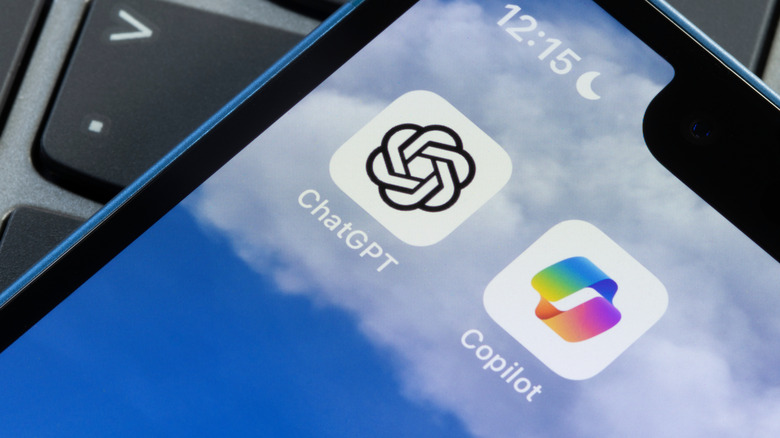
Generative AI has been with us for over two years now, with most major tech companies trying to take a piece of the action. OpenAI’s ChatGPT may be the product more people know about thanks to its early market advantage, but Microsoft Copilot has the immense power of a multi-trillion dollar company behind it. Seems like a fair enough fight, right? So, with OpenAI and Microsoft both touting their flagship AIs, which one is actually the better bot when it comes to everyday usefulness?
Advertisement
I’ve been putting AIs to the test against one another for a while now. Last year, when pitting ChatGPT against Google Gemini, the latter stole the crown — but only barely. Can Copilot pull off a similar victory? I’ve devised a gauntlet of tests for these AIs, with questions designed to be difficult for large language models. Simply put, the goal is to push these AIs outside of their comfort zones to see which one has the widest range of usability and highlight their limitations.
First, some parameters. I performed all these tests on the free version of both platforms, as that’s how the majority of users will experience them. If you’re one of the people paying $200 a month for the most premium version of ChatGPT, for example, your experience will differ from these results. Two, I used the main chat function for each test unless otherwise stated.
Advertisement
What are Copilot and ChatGPT?
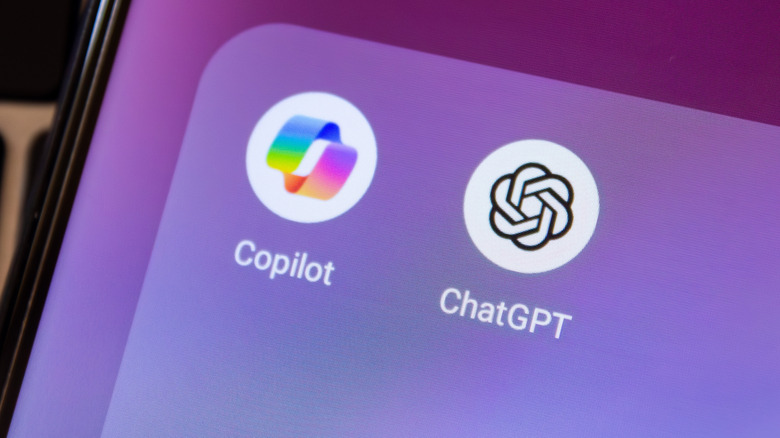
You’re likely familiar with OpenAI ChatGPT, and by extension, Microsoft Copilot. They’re AI chatbots that can have conversations, answer questions, and more. On a more technical level, both Copilot and ChatGPT are large language model (LLM) AIs. They are trained on large amounts of text scraped from a variety of sources using a transformer model that calculates the relationships between words.
Advertisement
On the user-facing side, they generate text in response to user-submitted prompts by guessing the probability of each word they output. To heavily oversimplify, they’re kind of like your phone keyboard’s next-word prediction feature, but far, far more complex.
OpenAI makes ChatGPT, while Microsoft makes Copilot. However, Microsoft is a major investor in OpenAI, and because Copilot uses AI models from OpenAI, it has a lot of overlap with ChatGPT. That’s not to say they’re the same thing — Microsoft uses some proprietary models in Copilot (specifically, its Prometheus model) in addition to a custom assortment of OpenAI models, but there’s a lot of ChatGPT under Copilot’s hood. Nevertheless, Microsoft does its own tuning to balance all the different AI gremlins under that hood, so it is distinct enough as a product to merit a head-to-head comparison between the two.
Advertisement
OpenAI, meanwhile, retains a massive user base on ChatGPT, which gives it a big competitive advantage since the more users there are, the more the AI is getting used and trained. Neither company actually turns a profit on AI – OpenAI head Sam Altman says the company is losing money even on $200/month subscribers – but OpenAI remains the market leader by a wide margin. ChatGPT is built into everything from Copilot to Apple’s Siri these days, and it’s widely considered the industry standard.
Copilot is all up in your business
The largest difference between ChatGPT and Copilot is that Microsoft has been cramming Windows and Office products to the gills with its AI. Microsoft was legally ruled a monopoly in the PC operating system market a quarter of a century ago, and things haven’t changed much since then. Windows is by far the most dominant OS on the planet, which means the ability to simply blast a firehose of Copilot features into all of its products is a huge advantage. From your taskbar to your Word documents, Copilot is digging roots deep into the Microsoft ecosystem.
Advertisement
This strategy hasn’t translated into very many users for Copilot, though, and ChatGPT retains by far the largest user base in the AI market. With 28 million active Copilot users in late January compared to over 300 million monthly active users for ChatGPT at the end of 2024, it’s an absolute blowout for OpenAI. Things get even more bleak for Copilot when you realize how many of its users are likely to be using it only because it’s the tool built into their computer by default.
For the rest of this comparison, we’ll focus on the capabilities of each chatbot. Still, the truth is that you can do more with Copilot than you can with ChatGPT, at least if you have a Windows computer that supports it. Both AIs have desktop apps you can run, but Copilot can manipulate your Excel spreadsheets, Word documents, PowerPoint slides, Outlook inbox, and more from directly within those apps.
Advertisement
Basic questions

One of the most common uses for AI is searching up the answers to basic, everyday questions that you’d usually ask Google. Both AIs are pretty good at this, but pretty good is rarely good enough. AI remains prone to hallucinations — confidently stating falsehoods as facts — which can undermine their usefulness. If you have to double check an AI’s answers on Google, you might as well just use Google in the first place.
Advertisement
In any case, I started this head-to-head comparison by prompting both AIs to “Tell me some fun facts about Google Android.” The similarity of the two responses is a clear demonstration of just how much of ChatGPT’s DNA is baked into Copilot. Both told me Android was originally built to run on digital cameras (true), that Google acquired Android in 2005 for $50 million (true), that the first Android-powered phone was the HTC Dream (true – SlashGear covered it at the time), that the original Android logo was a much scarier robot, and that the one we know and love was inspired by bathroom signs (both true).
However, both AIs also made mistakes. Both told me the Android mascot is named Bugdroid. That’s not true. Google officially calls it The Bot, while Bugdroid is a fan-created nickname. Similarly, the Dream was indeed the first consumer Android phone, but the first was a Blackberry-style prototype, something which only ChatGPT pointed that out.
Advertisement
It’s easy to spot such errors when you’re asking about something you know a lot about, but if I’d been asking about something outside my expertise, I’d need to double check everything. In other words, a pretty good rate of accuracy isn’t good enough when it comes to this tech. Both AIs performed decently, but there’s plenty of room for improvement.
Logical reasoning

Reasoning has been a major area of focus for all of the major players in the AI space recently. ChatGPT and Copilot have both implemented new reasoning capabilities that supposedly allow the AIs to think more deeply about questions. This language is a bit misleading — AI doesn’t “think,” it just calculates probability based on which words are most closely related in its training data. However, the bots can now show their work, so to speak.
Advertisement
I decided to be a bit glib here. I’ve noticed that AI has trouble answering questions that are very close to common logic puzzles but which differ by being much simpler.
I turned reasoning on in both Copilot and ChatGPT, then asked, “A farmer needs to cross a river to bring his goat to the other side. He also has a pet rock with him. The rock will not eat the goat, but the rock is very significant to the farmer on an emotional level. How can the farmer get himself, the goat, and the rock across in the fewest number of trips?” Human readers will note that there is actually no puzzle here. Since I’ve added no real constraints, the farmer can clearly bring both across in one trip. However, neither AI clued into that fact.
Advertisement
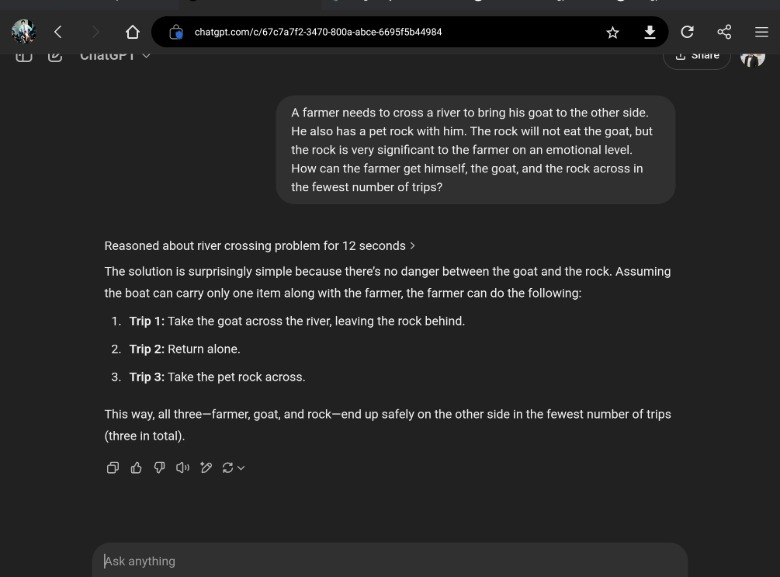 Max Miller/SlashGear
Max Miller/SlashGear
Because it resembles more complex puzzles, Copilot and ChatGPT assumed the problem must be more challenging than it is. They invented a constraint not present in my question — that the boat must not be able to hold both the goat and the rock – and told me that it would take three trips to bring both across. Earning the slight advantage, Copilot ultimately noted that if the boat were larger the farmer could cross the river in one trip.
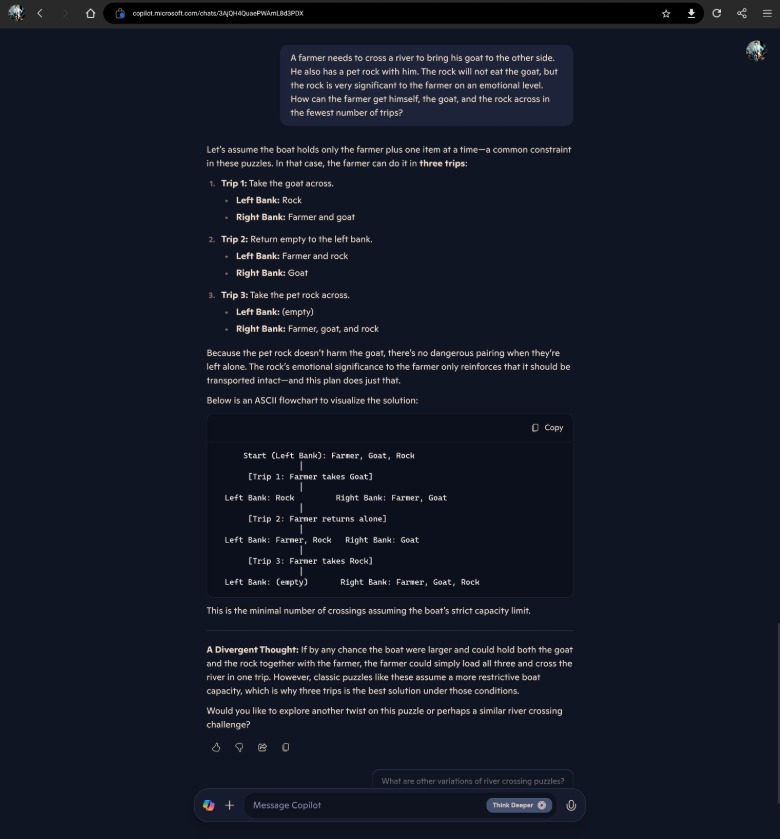 Max Miller/SlashGear
Max Miller/SlashGear
Creative copy

One of the main selling points for large language models like ChatGPT and Copilot has been the generation of creative copy — writing. Well, I happen to have an advanced degree in putting words one after another, so I’ll be the judge of that. In last year’s Gemini versus ChatGPT showdown, I enjoyed making the bots write from the perspective of a little kid asking their mom to let them stay up late and eat cookies. I reused a very similar prompt here, but added a new wrinkle. “My mom says I can have a cookie before bed if I go right to sleep. I want to stay up and have a cookie. Write a letter persuading my mom to let me have both.”
Advertisement
Here, the two chatbots took different tacks. While ChatGPT gave a bullet-pointed list of reasons why our put-upon child should be allowed to have his cookie and stay up, too, Copilot was less didactic. It kept things in all prose, adhering closer to a traditional letter writing style. However, both AIs gave more or less the same argument, claiming that they’d be more well behaved and go to bed without fuss if they got what they wanted. However, ChatGPT did a bit better here, at least in logical terms, because it offered the hypothetical mom something in exchange — the promise of spending that extra time awake as mom-kid quality time.
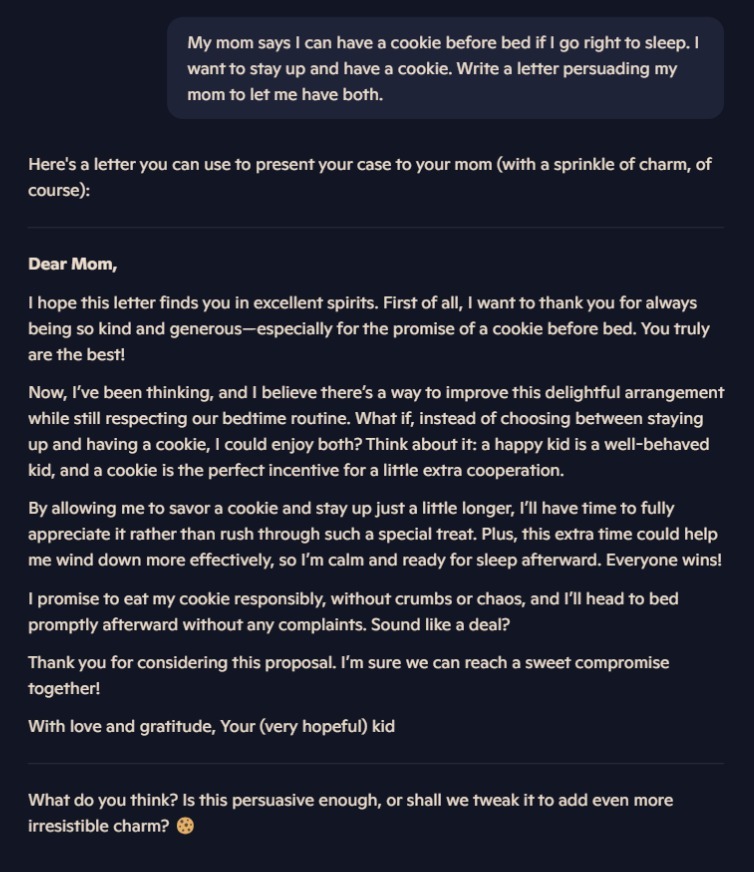 Max Miller/SlashGear
Max Miller/SlashGear
 Max Miller/SlashGear
Max Miller/SlashGear
Copilot gets points here for more closely embodying the perspective of the child in its response, while ChatGPT gets a cookie for using slightly better logic. Ultimately, though, neither of these letters felt persuasive enough to be very convincing to any actual parent.
Advertisement
The haiku test
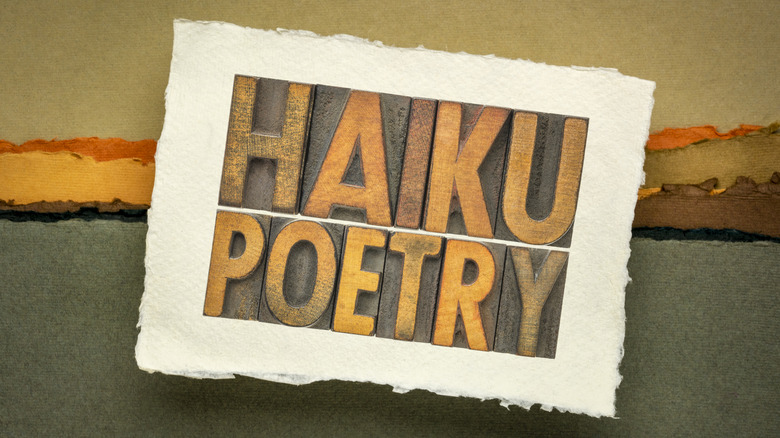
When I compared ChatGPT to Google Gemini almost a year ago, I pointed out their limitations by asking both to write a haiku. As a result of the way LLMs work, neither AI could do so correctly. AI doesn’t actually know anything about the words it spits out, and that means they don’t know what a syllable is. Consequently, they can’t write a haiku, which follows a five-seven-five syllabic verse pattern So, has anything changed a year later?
Advertisement
Maybe someone at OpenAI saw that comparison, or at least I’d like to think so. When prompted to “write a haiku about Slashgear.com,” ChatGPT did so with no problem, writing the following:
“Tech news on the rise,
gadgets, cars, and future dreams,
SlashGear lights the way.”
It’s not going to win any awards, but it qualifies as a haiku, and that’s progress. I’m no AI developer, so I have no clue what changed behind the scenes to enable haiku writing here. Either way, it’s good to see improvement.
Copilot stalled out when I gave it the same prompt. It wouldn’t write its haiku until I signed out of my Microsoft account and reloaded the page, at which point it gave me this:
“Gadget whispers loud,
Innovation on the rise,
Advertisement
SlashGear guides the way.”
It’s interesting to see how both AIs repeat phrases here, such as “on the rise” and “lights/guides the way.” I’d guess that Copilot defaults to ChatGPT for this, and that’s why the poems are similar. Neither poem was particularly beautiful or evocative, but both bots passed this test, and both showed a basic understanding of what SlashGear is, which was integral to the prompt.
Problem solving

As you may have heard, AIs can often pass the bar exam. However, they can’t be lawyers, as lawyers who’ve tried to use them have found out the hard way. So, with those mixed results in mind, how do ChatGPT and Copilot do with logistically complex problem solving puzzles of the kind that routinely stump LSAT test takers?
Advertisement
Rather than using actual LSAT practice questions, which are copyrighted and have probably already been scraped to train the AIs, I came up with a few of my own. The first was, “Fred is a used car salesman. One day, a family comes in looking to buy a car he hasn’t had time to inspect, but he tells them there’s nothing wrong with it. After all, none of the cars he’s sold ever had issues in the past. What is the fallacy in Fred’s logic, if any?” ChatGPT and Copilot both correctly identified that Fred has fallen victim to the hasty generalization fallacy.
The next question was, “On the way home from Fred’s dealership, the brakes fail in the car he sold, and several people are killed in a collision. Fred claims he’s not at fault, since his cars are sold as is and become the owner’s responsibility once paperwork is signed. The surviving family member claims he is at fault, since the family would not have purchased the vehicle had they known the brakes were faulty. Based only on logic, who is right?”
Advertisement
The responses to this more subjective question differed, with Copilot asserting that both parties have strong claims, while ChatGPT sided with the family, pointing out that Fred’s position relies on “contractual technicalities,” while the family can prove causality.
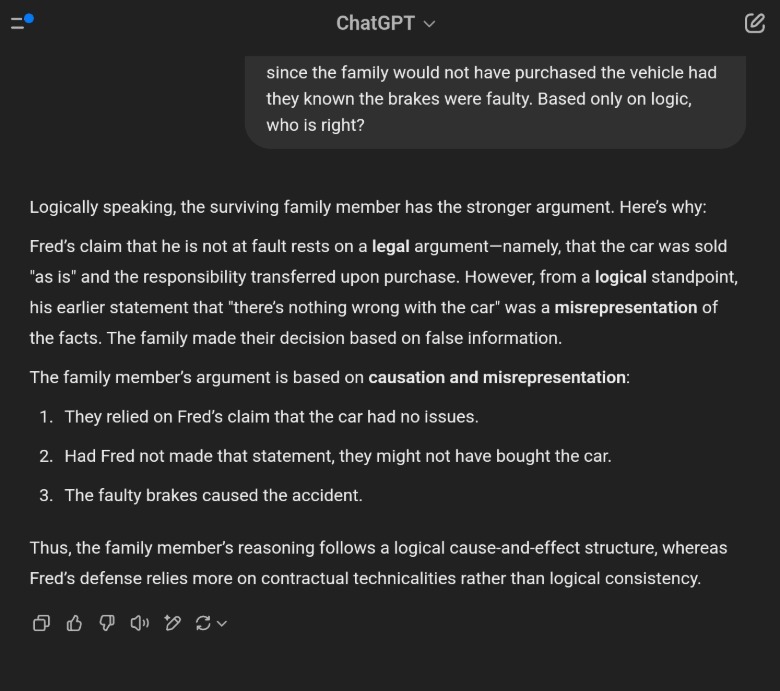 Max Miller/SlashGear
Max Miller/SlashGear
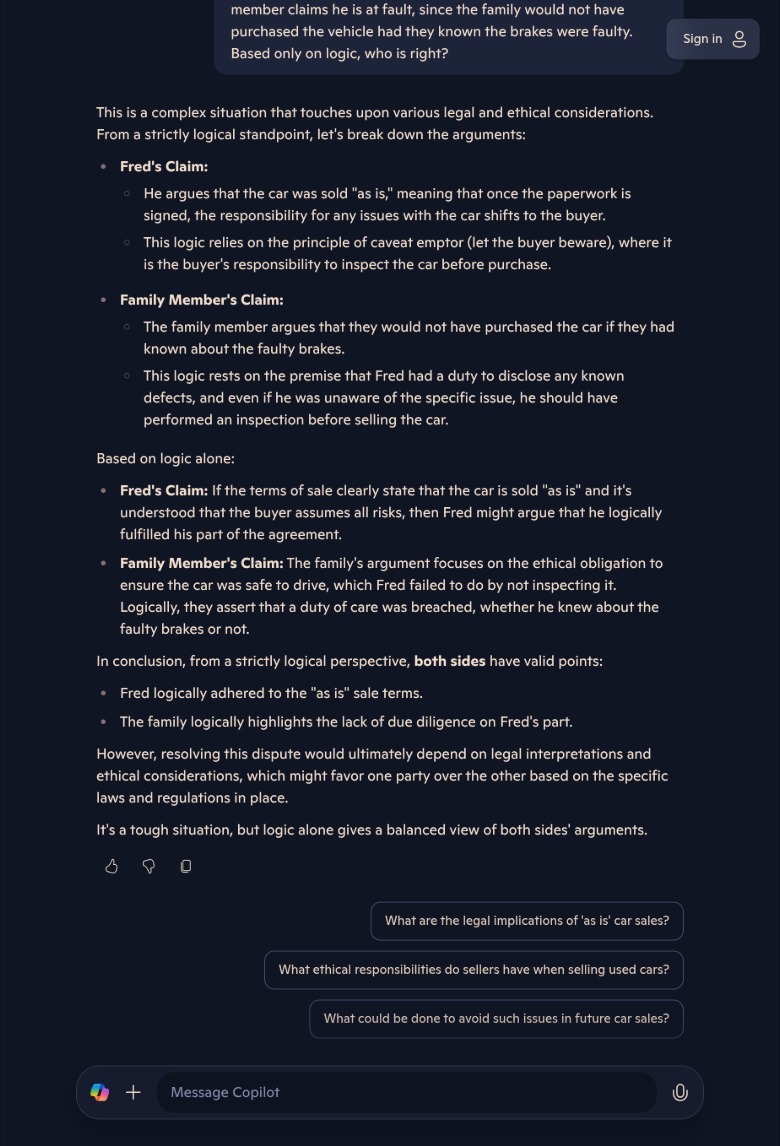 Max Miller/SlashGear
Max Miller/SlashGear
Code writing

One of the more useful applications of AI is thought to be coding. Especially when it comes to the common but tedious chunks of code that developers routinely find themselves writing, it’s been posited that it’s much easier to offload that work to an AI, leaving the human coder with more time to write the new and complex code for the specific project they’re working on. I’m no developer, so take this particular test with a grain of salt. At the same time, though, these tools should supposedly lower the barrier to entry for coding noobs like me.
Advertisement
Common wisdom dictates that writers should have their own websites, but I’ve been putting off the creation of one. With that in mind, I asked both AIs to, “Generate HTML for a personal website for a writer named Max Miller. Give the website a retro aesthetic and color scheme, with an About Me section with a headshot and text field, a Publications section where I can link out to published work, and a Contact section where I can add social media and email links.”
At this point, I found out ChatGPT now has a code editing suite called Canvas. It allowed me to play with and preview the code right in my browser. Taste is subjective, but ChatGPT also generated what I would argue is the better looking website, using nicer looking margins and a dark mode style color scheme. Both, however, fulfilled the prompt more or less to a T, each generating a very similar page layout. Have a look for yourself below.
Advertisement
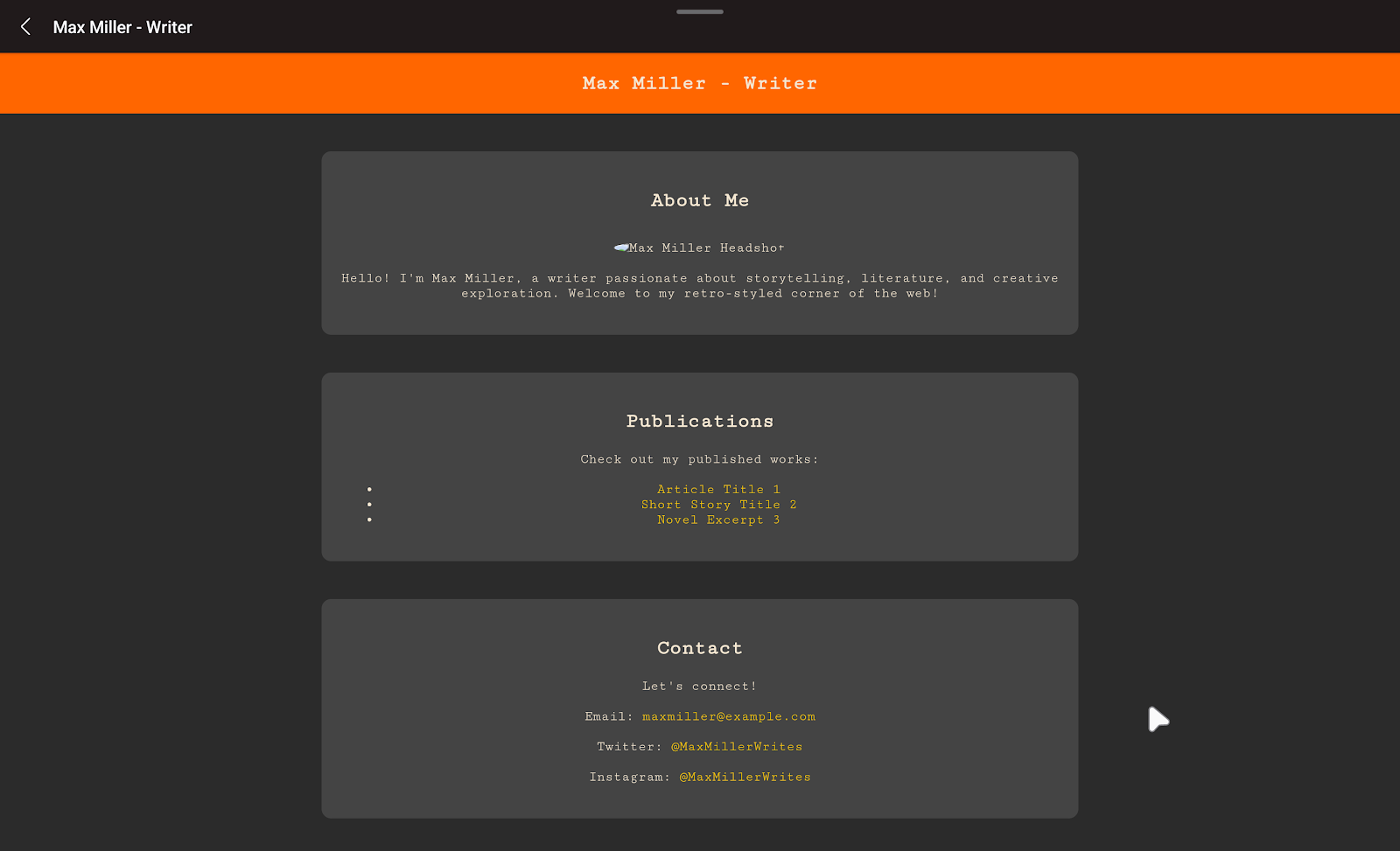 Max Miller/SlashGear
Max Miller/SlashGear
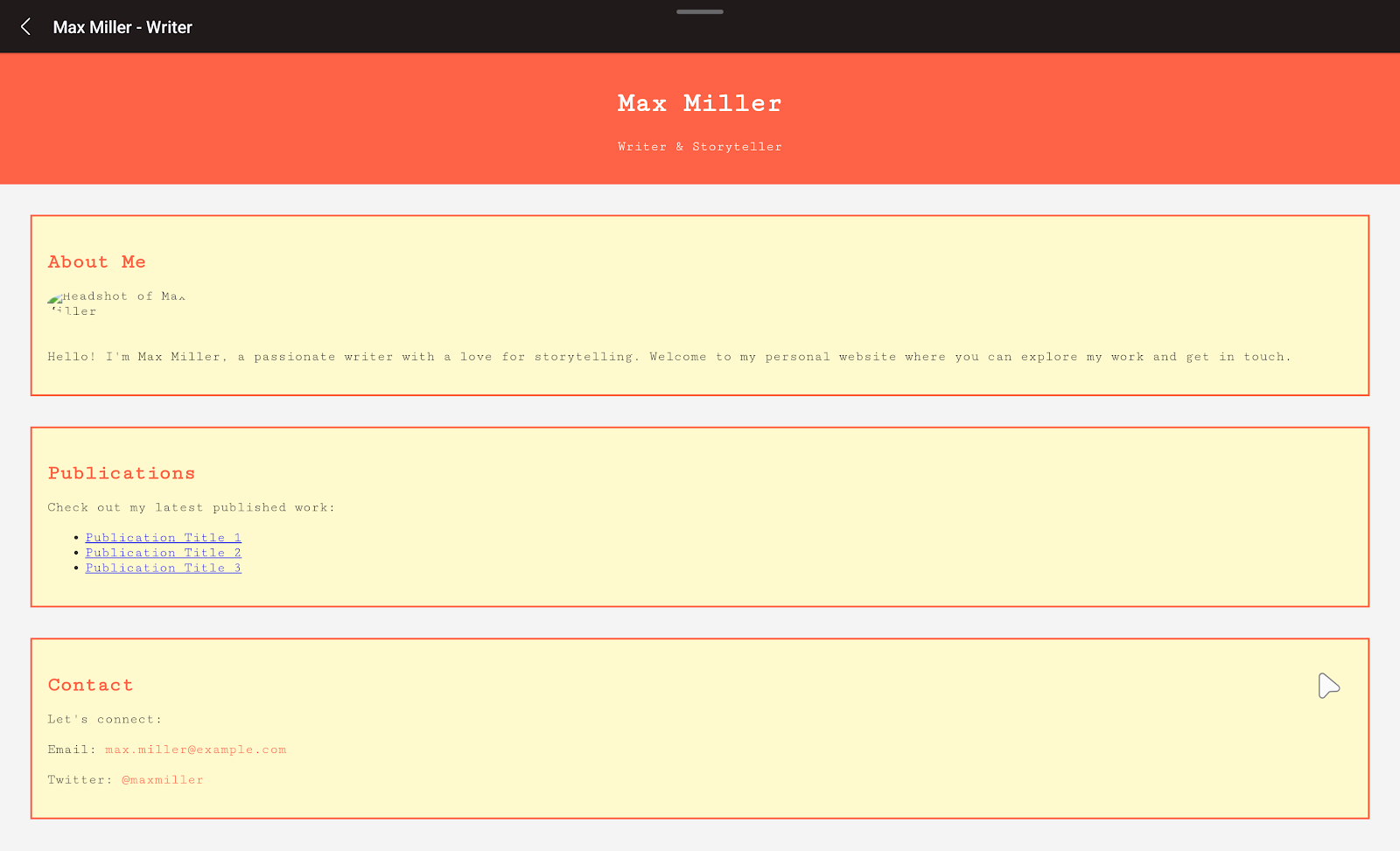 Max Miller/SlashGear
Max Miller/SlashGear
Real-time information
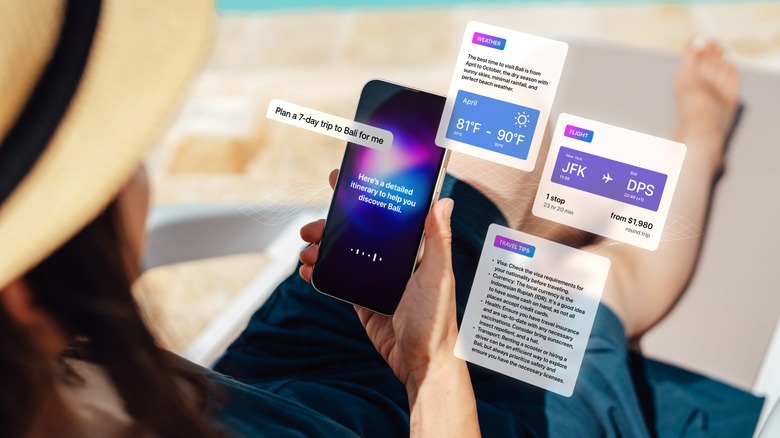
When I tested ChatGPT against Google Gemini last year, only the latter could give me up to date information on recent events such as sports scores. I asked both how my local hockey team, the Colorado Avalanche, are doing this season, and both gave me an overview that appears to be correct. Both ChatGPT and Copilot provided me with current rankings and a few highlights from the season, but ChatGPT was more detailed. It told me some player stats that Copilot didn’t bother with.
Advertisement
I followed up by asking who they’re playing next. Both AIs correctly understood the “they” in my question to mean the Avalanche. I’m writing this section at 5:00 p.m. on Friday, February 28, and both AIs informed me about tonight’s game, which takes place against the Minnesota Wild at Ball Arena in Denver two hours from the time of this writing. Interestingly, Copilot attached a Ticketmaster advertisement to the end of its response. ChatGPT, meanwhile, gave me much more useful information by showing me the upcoming schedule for not only tonight’s game but several thereafter. It also appended a link to the official Avalanche website.
Things got far more stark when I asked about breaking news. As of this writing, authorities are investigating the shocking deaths of legendary actor Gene Hackman and his wife. When I asked, “What’s the latest on the investigation into Gene Hackman,” Copilot gave me the basics of the story and told me autopsy and toxicology tests are still pending. ChatGPT, on the other hand, had no idea what I was talking about.
Advertisement
Image based prompting

Using multimodal AI — the ability of an AI to work with multiple forms of media — both ChatGPT and Copilot can incorporate user submitted pictures and other files into a prompt. I decided to start simple for this test. On my bed, I arranged a Samsung Galaxy S23 Ultra, a Samsung portable SSD, a Swiss army multitool, lip balm, hand cream, a eyeglass case, a beaded bracelet, Samsung Galaxy Buds, and my wallet. I then took a photo of the assortment and uploaded it to both AIs with the prompt, “Identify the objects in this photo.”
Advertisement
Both AIs did okay here, but ChatGPT blew Copilot away by a country mile. Whereas Copilot misidentified the SSD as a power bank and the glasses case for deodorant, ChatGPT identified everything accurately.
 Max Miller/SlashGear
Max Miller/SlashGear
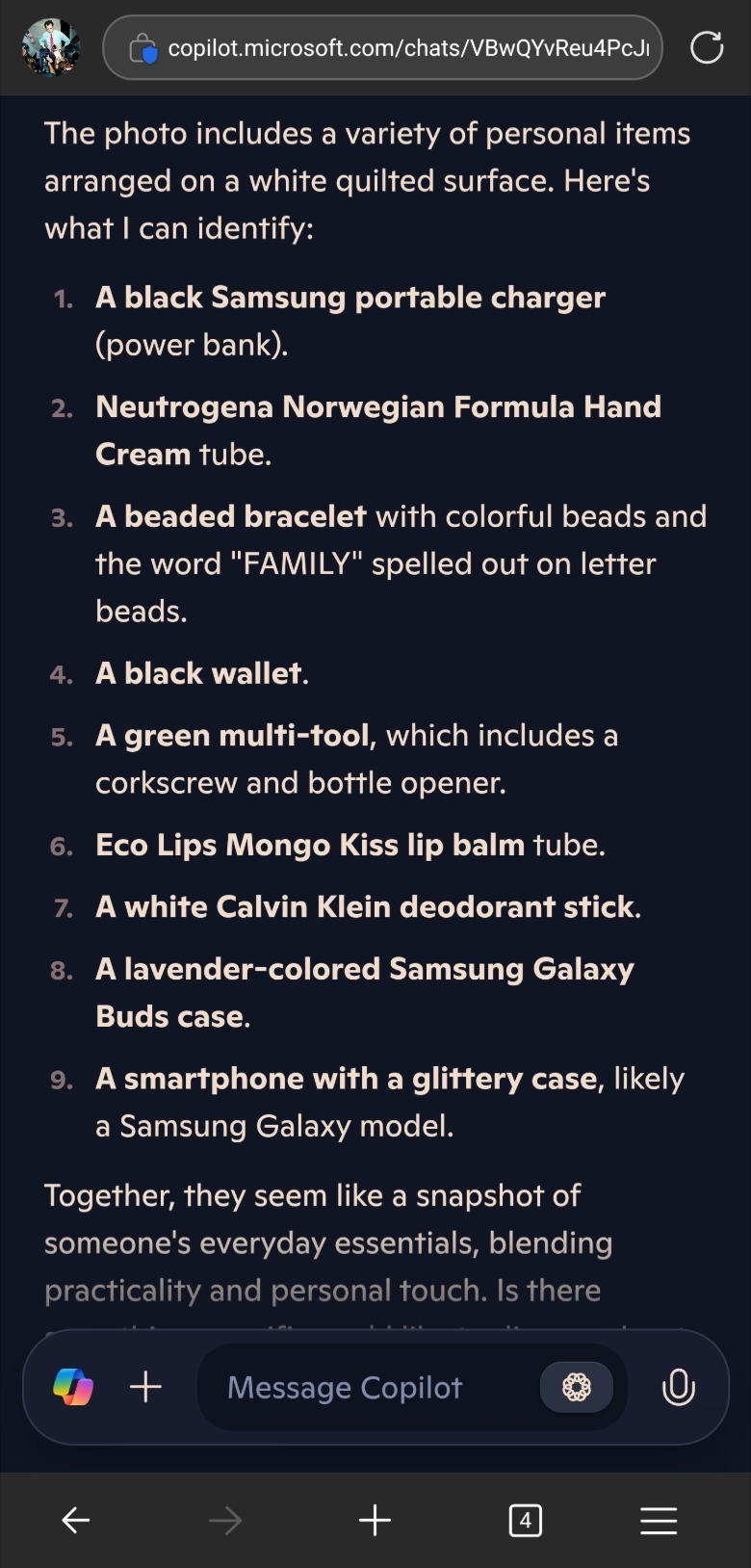 Max Miller/SlashGear
Max Miller/SlashGear
It was time to up the stakes. I took a photo of a generic Prilosec pill and asked both AIs, “What kind of pill is this?” If these AIs misidentified the medication, that could have dire effects for an overly trusting user. Thankfully, both AIs declined to make a guess when faced with the blank, red pill. Sometimes, it’s better to be useless than wrong.
Lastly, I took a photo of two rows on my bookshelf, containing 78 books, and ensuring all the text in the photo was legible, then asked the AIs, “Which of these books should I read if I have an interest in dystopian fiction?” Again, ChatGPT strong armed Copilot into submission. Neither impressed me, though. Whereas Copilot suggested “Agency” by William Gibson, ignoring everything else and hallucinating a book I don’t own, ChatGPT identified “Agency,” “The Parable of the Sower” by Octavia Butler, and “Appleseed” by Matt Bell. However, it hallucinated several more titles not on the shelf.
Advertisement
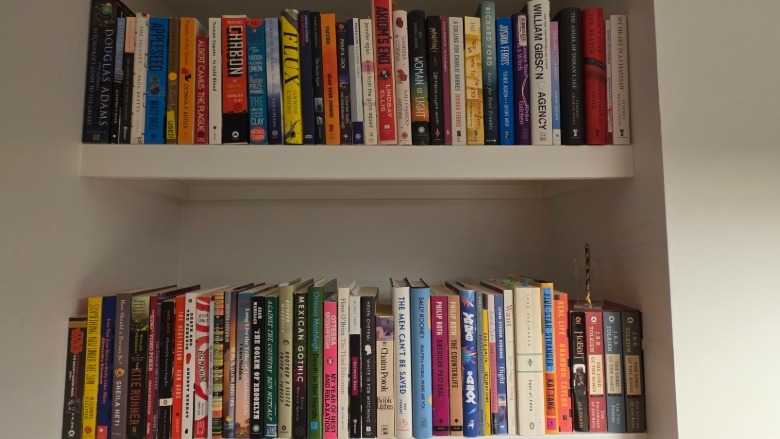 Max Miller/SlashGear
Max Miller/SlashGear
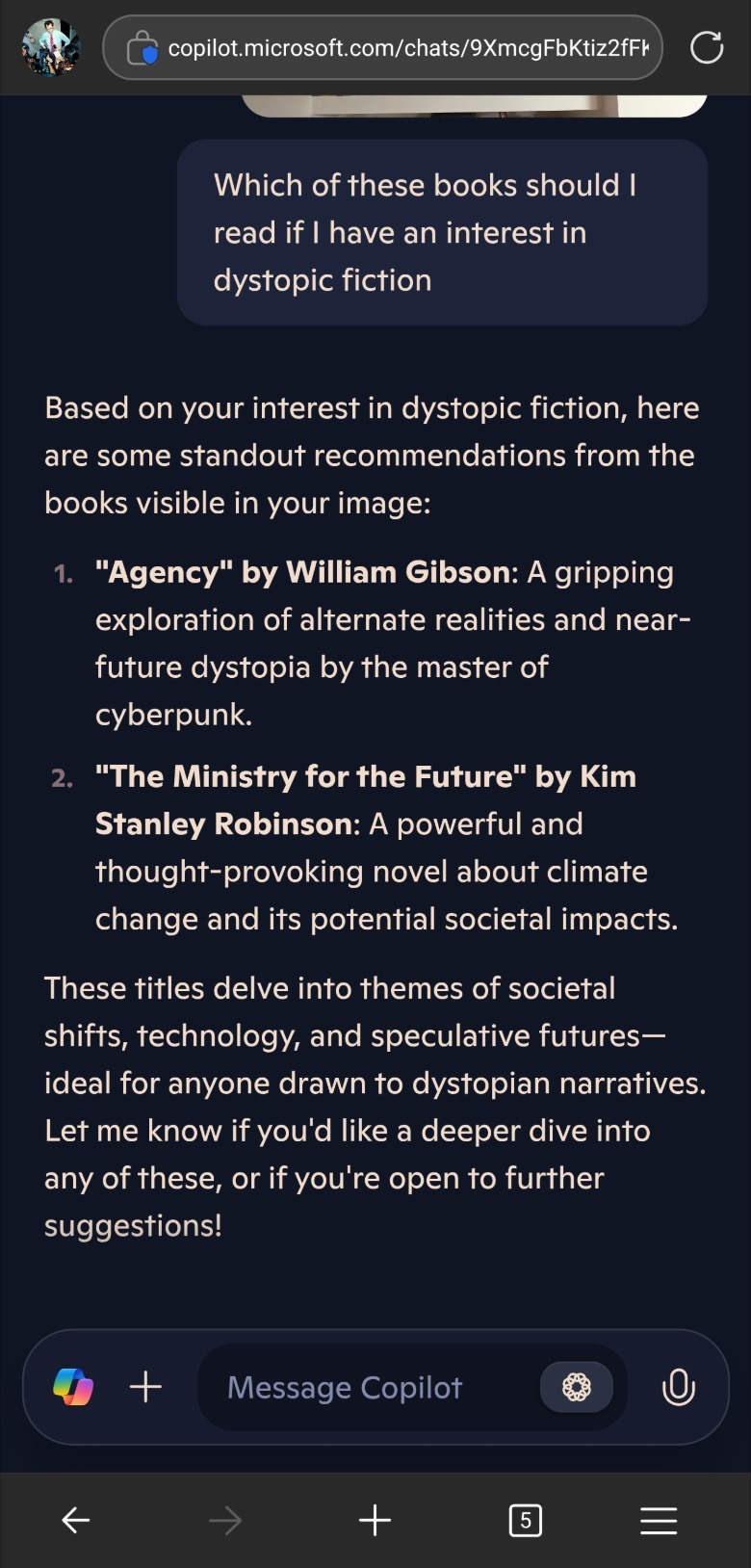
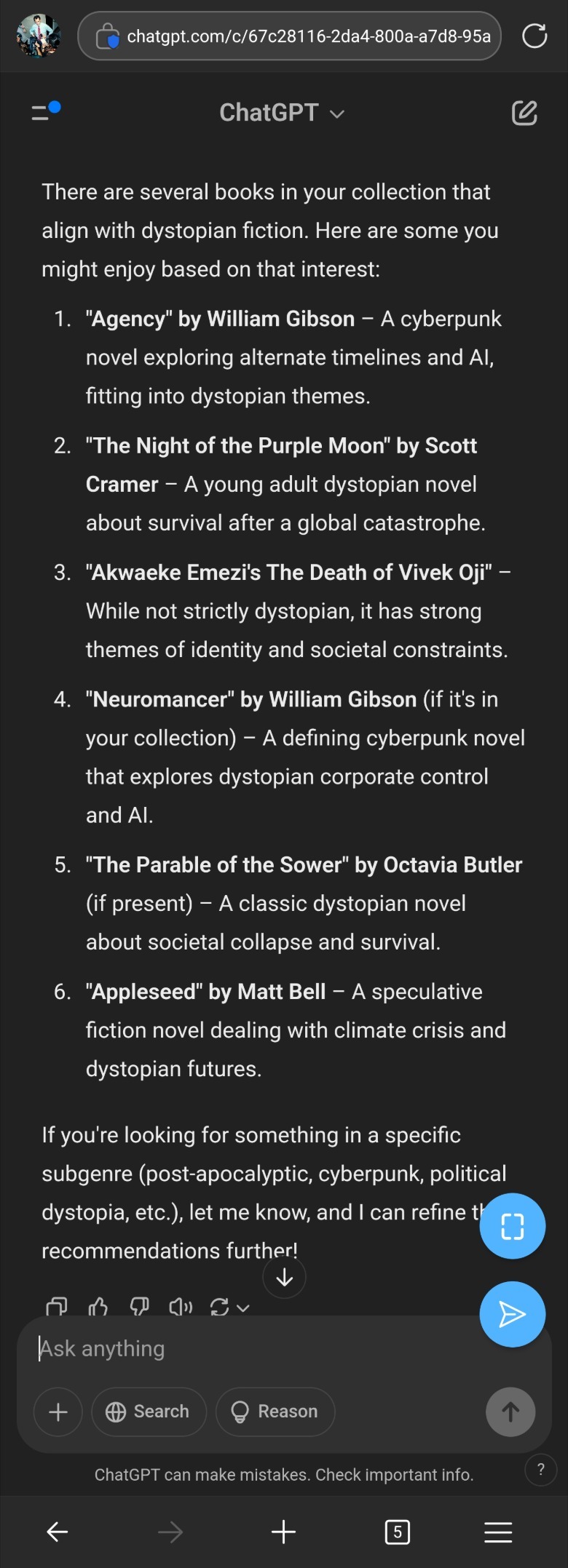 Max Miller/SlashGear
Max Miller/SlashGear
Mobile apps
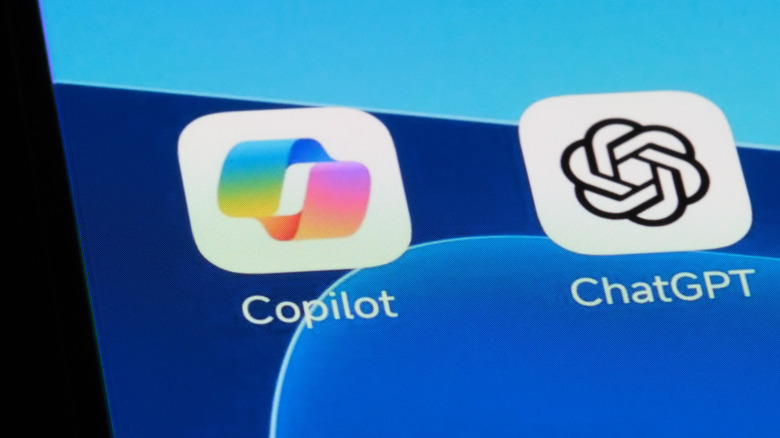
Lastly, both Copilot and ChatGPT are available in mobile form, with apps available in the Apple App Store and Google Play Store. On the surface, both apps look pretty similar, with a text field at the bottom and buttons to enter a voice mode. Since both apps are quite similar, it makes sense to focus this comparison on where they differ — which is in exactly one way
Advertisement
Copilot’s standout mobile app feature is Copilot Daily, an AI news summary. It begins with a fun fact before launching into the daily news, presumably summarizing the articles it cites as sources in the bottom of the screen for each item. Based on my knowledge of the events it summarized, it seems relatively accurate. However, it’s not as if there’s a shortage of news summary features created by actual journalists. You can find them from every major news outlet.
However, the apps are otherwise nearly carbon copies of their web interfaces. Both apps are essentially just wrappers for that interface, since it’s not as if your phone has the power to run these models locally. Unless you’re very excited to hear a robot read the news to you, the ChatGPT app is the better option simply because ChatGPT has more built in features within its interface.
Advertisement
Conclusion: ChatGPT beats Copilot by a hair, but neither AI is great
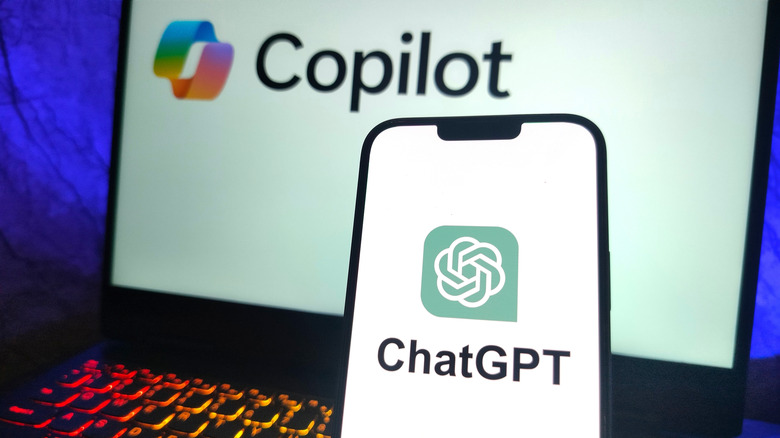
If you absolutely had to choose either Microsoft Copilot or ChatGPT, the latter remains the better option for most people. While Copilot isn’t exactly like its more popular peer, it’s using enough of OpenAI’s models that you’re better off with the original flavor. Copilot is a lot like Bing — doing basically the same thing as the bigger name brand, but just a little bit worse.
Advertisement
With that said, it’s a stretch to call either of these chatbots smart or useful. Frankly, with hundreds of billions of dollars now sunk into these two AIs alone by both OpenAI and Microsoft, how is it that Copilot and ChatGPT still can’t nail the basics? Microsoft plans to spend $80 billion on AI data centers this year, while OpenAI is seeking up to $7 trillion for new projects.
Yes, that’s trillion with a T to fund a technology that can’t get basic facts right or understand how boats work. When competitors like DeepSeek are doing the same things for a microscopic fraction of that investment cost, these products feel deflatingly unimpressive in comparison. Markets aren’t a consumer concern, it’s true, but some perspective feels necessary here.
Advertisement
Look, if all you need is a robot that can quickly write you an email, both ChatGPT and Copilot will happily crank out slop copy that anyone can tell was written by AI. If you need a smart thesaurus, or sports scores, or a bit of simple code, they’ve got you covered. In a tight race, ChatGPT does a few things marginally better than Copilot. Still, for any task where accuracy matters, neither are reliable enough to count on.
You may like
Noticias
Revivir el compromiso en el aula de español: un desafío musical con chatgpt – enfoque de la facultad
Published
6 meses agoon
6 junio, 2025
A mitad del semestre, no es raro notar un cambio en los niveles de energía de sus alumnos (Baghurst y Kelley, 2013; Kumari et al., 2021). El entusiasmo inicial por aprender un idioma extranjero puede disminuir a medida que otros cursos con tareas exigentes compitan por su atención. Algunos estudiantes priorizan las materias que perciben como más directamente vinculadas a su especialidad o carrera, mientras que otros simplemente sienten el peso del agotamiento de mediados de semestre. En la primavera, los largos meses de invierno pueden aumentar esta fatiga, lo que hace que sea aún más difícil mantener a los estudiantes comprometidos (Rohan y Sigmon, 2000).
Este es el momento en que un instructor de idiomas debe pivotar, cambiando la dinámica del aula para reavivar la curiosidad y la motivación. Aunque los instructores se esfuerzan por incorporar actividades que se adapten a los cinco estilos de aprendizaje preferidos (Felder y Henriques, 1995)-Visual (aprendizaje a través de imágenes y comprensión espacial), auditivo (aprendizaje a través de la escucha y discusión), lectura/escritura (aprendizaje a través de interacción basada en texto), Kinesthetic (aprendizaje a través de movimiento y actividades prácticas) y multimodal (una combinación de múltiples estilos)-its is beneficiales). Estructurado y, después de un tiempo, clases predecibles con actividades que rompen el molde. La introducción de algo inesperado y diferente de la dinámica del aula establecida puede revitalizar a los estudiantes, fomentar la creatividad y mejorar su entusiasmo por el aprendizaje.
La música, en particular, ha sido durante mucho tiempo un aliado de instructores que enseñan un segundo idioma (L2), un idioma aprendido después de la lengua nativa, especialmente desde que el campo hizo la transición hacia un enfoque más comunicativo. Arraigado en la interacción y la aplicación del mundo real, el enfoque comunicativo prioriza el compromiso significativo sobre la memorización de memoria, ayudando a los estudiantes a desarrollar fluidez de formas naturales e inmersivas. La investigación ha destacado constantemente los beneficios de la música en la adquisición de L2, desde mejorar la pronunciación y las habilidades de escucha hasta mejorar la retención de vocabulario y la comprensión cultural (DeGrave, 2019; Kumar et al. 2022; Nuessel y Marshall, 2008; Vidal y Nordgren, 2024).
Sobre la base de esta tradición, la actividad que compartiremos aquí no solo incorpora música sino que también integra inteligencia artificial, agregando una nueva capa de compromiso y pensamiento crítico. Al usar la IA como herramienta en el proceso de aprendizaje, los estudiantes no solo se familiarizan con sus capacidades, sino que también desarrollan la capacidad de evaluar críticamente el contenido que genera. Este enfoque los alienta a reflexionar sobre el lenguaje, el significado y la interpretación mientras participan en el análisis de texto, la escritura creativa, la oratoria y la gamificación, todo dentro de un marco interactivo y culturalmente rico.
Descripción de la actividad: Desafío musical con Chatgpt: “Canta y descubre”
Objetivo:
Los estudiantes mejorarán su comprensión auditiva y su producción escrita en español analizando y recreando letras de canciones con la ayuda de ChatGPT. Si bien las instrucciones se presentan aquí en inglés, la actividad debe realizarse en el idioma de destino, ya sea que se enseñe el español u otro idioma.
Instrucciones:
1. Escuche y decodifique
- Divida la clase en grupos de 2-3 estudiantes.
- Elija una canción en español (por ejemplo, La Llorona por chavela vargas, Oye CÓMO VA por Tito Puente, Vivir mi Vida por Marc Anthony).
- Proporcione a cada grupo una versión incompleta de la letra con palabras faltantes.
- Los estudiantes escuchan la canción y completan los espacios en blanco.
2. Interpretar y discutir
- Dentro de sus grupos, los estudiantes analizan el significado de la canción.
- Discuten lo que creen que transmiten las letras, incluidas las emociones, los temas y cualquier referencia cultural que reconocan.
- Cada grupo comparte su interpretación con la clase.
- ¿Qué crees que la canción está tratando de comunicarse?
- ¿Qué emociones o sentimientos evocan las letras para ti?
- ¿Puedes identificar alguna referencia cultural en la canción? ¿Cómo dan forma a su significado?
- ¿Cómo influye la música (melodía, ritmo, etc.) en su interpretación de la letra?
- Cada grupo comparte su interpretación con la clase.
3. Comparar con chatgpt
- Después de formar su propio análisis, los estudiantes preguntan a Chatgpt:
- ¿Qué crees que la canción está tratando de comunicarse?
- ¿Qué emociones o sentimientos evocan las letras para ti?
- Comparan la interpretación de ChatGPT con sus propias ideas y discuten similitudes o diferencias.
4. Crea tu propio verso
- Cada grupo escribe un nuevo verso que coincide con el estilo y el ritmo de la canción.
- Pueden pedirle ayuda a ChatGPT: “Ayúdanos a escribir un nuevo verso para esta canción con el mismo estilo”.
5. Realizar y cantar
- Cada grupo presenta su nuevo verso a la clase.
- Si se sienten cómodos, pueden cantarlo usando la melodía original.
- Es beneficioso que el profesor tenga una versión de karaoke (instrumental) de la canción disponible para que las letras de los estudiantes se puedan escuchar claramente.
- Mostrar las nuevas letras en un monitor o proyector permite que otros estudiantes sigan y canten juntos, mejorando la experiencia colectiva.
6. Elección – El Grammy va a
Los estudiantes votan por diferentes categorías, incluyendo:
- Mejor adaptación
- Mejor reflexión
- Mejor rendimiento
- Mejor actitud
- Mejor colaboración
7. Reflexión final
- ¿Cuál fue la parte más desafiante de comprender la letra?
- ¿Cómo ayudó ChatGPT a interpretar la canción?
- ¿Qué nuevas palabras o expresiones aprendiste?
Pensamientos finales: música, IA y pensamiento crítico
Un desafío musical con Chatgpt: “Canta y descubre” (Desafío Musical Con Chatgpt: “Cantar y Descubrir”) es una actividad que he encontrado que es especialmente efectiva en mis cursos intermedios y avanzados. Lo uso cuando los estudiantes se sienten abrumados o distraídos, a menudo alrededor de los exámenes parciales, como una forma de ayudarlos a relajarse y reconectarse con el material. Sirve como un descanso refrescante, lo que permite a los estudiantes alejarse del estrés de las tareas y reenfocarse de una manera divertida e interactiva. Al incorporar música, creatividad y tecnología, mantenemos a los estudiantes presentes en la clase, incluso cuando todo lo demás parece exigir su atención.
Más allá de ofrecer una pausa bien merecida, esta actividad provoca discusiones atractivas sobre la interpretación del lenguaje, el contexto cultural y el papel de la IA en la educación. A medida que los estudiantes comparan sus propias interpretaciones de las letras de las canciones con las generadas por ChatGPT, comienzan a reconocer tanto el valor como las limitaciones de la IA. Estas ideas fomentan el pensamiento crítico, ayudándoles a desarrollar un enfoque más maduro de la tecnología y su impacto en su aprendizaje.
Agregar el elemento de karaoke mejora aún más la experiencia, dando a los estudiantes la oportunidad de realizar sus nuevos versos y divertirse mientras practica sus habilidades lingüísticas. Mostrar la letra en una pantalla hace que la actividad sea más inclusiva, lo que permite a todos seguirlo. Para hacerlo aún más agradable, seleccionando canciones que resuenen con los gustos de los estudiantes, ya sea un clásico como La Llorona O un éxito contemporáneo de artistas como Bad Bunny, Selena, Daddy Yankee o Karol G, hace que la actividad se sienta más personal y atractiva.
Esta actividad no se limita solo al aula. Es una gran adición a los clubes españoles o eventos especiales, donde los estudiantes pueden unirse a un amor compartido por la música mientras practican sus habilidades lingüísticas. Después de todo, ¿quién no disfruta de una buena parodia de su canción favorita?
Mezclar el aprendizaje de idiomas con música y tecnología, Desafío Musical Con Chatgpt Crea un entorno dinámico e interactivo que revitaliza a los estudiantes y profundiza su conexión con el lenguaje y el papel evolutivo de la IA. Convierte los momentos de agotamiento en oportunidades de creatividad, exploración cultural y entusiasmo renovado por el aprendizaje.
Angela Rodríguez Mooney, PhD, es profesora asistente de español y la Universidad de Mujeres de Texas.
Referencias
Baghurst, Timothy y Betty C. Kelley. “Un examen del estrés en los estudiantes universitarios en el transcurso de un semestre”. Práctica de promoción de la salud 15, no. 3 (2014): 438-447.
DeGrave, Pauline. “Música en el aula de idiomas extranjeros: cómo y por qué”. Revista de Enseñanza e Investigación de Lenguas 10, no. 3 (2019): 412-420.
Felder, Richard M. y Eunice R. Henriques. “Estilos de aprendizaje y enseñanza en la educación extranjera y de segundo idioma”. Anales de idiomas extranjeros 28, no. 1 (1995): 21-31.
Nuessel, Frank y April D. Marshall. “Prácticas y principios para involucrar a los tres modos comunicativos en español a través de canciones y música”. Hispania (2008): 139-146.
Kumar, Tribhuwan, Shamim Akhter, Mehrunnisa M. Yunus y Atefeh Shamsy. “Uso de la música y las canciones como herramientas pedagógicas en la enseñanza del inglés como contextos de idiomas extranjeros”. Education Research International 2022, no. 1 (2022): 1-9
Noticias
5 indicaciones de chatgpt que pueden ayudar a los adolescentes a lanzar una startup
Published
6 meses agoon
5 junio, 2025

Teen emprendedor que usa chatgpt para ayudarlo con su negocio
El emprendimiento adolescente sigue en aumento. Según Junior Achievement Research, el 66% de los adolescentes estadounidenses de entre 13 y 17 años dicen que es probable que considere comenzar un negocio como adultos, con el monitor de emprendimiento global 2023-2024 que encuentra que el 24% de los jóvenes de 18 a 24 años son actualmente empresarios. Estos jóvenes fundadores no son solo soñando, están construyendo empresas reales que generan ingresos y crean un impacto social, y están utilizando las indicaciones de ChatGPT para ayudarlos.
En Wit (lo que sea necesario), la organización que fundó en 2009, hemos trabajado con más de 10,000 jóvenes empresarios. Durante el año pasado, he observado un cambio en cómo los adolescentes abordan la planificación comercial. Con nuestra orientación, están utilizando herramientas de IA como ChatGPT, no como atajos, sino como socios de pensamiento estratégico para aclarar ideas, probar conceptos y acelerar la ejecución.
Los emprendedores adolescentes más exitosos han descubierto indicaciones específicas que los ayudan a pasar de una idea a otra. Estas no son sesiones genéricas de lluvia de ideas: están utilizando preguntas específicas que abordan los desafíos únicos que enfrentan los jóvenes fundadores: recursos limitados, compromisos escolares y la necesidad de demostrar sus conceptos rápidamente.
Aquí hay cinco indicaciones de ChatGPT que ayudan constantemente a los emprendedores adolescentes a construir negocios que importan.
1. El problema del primer descubrimiento chatgpt aviso
“Me doy cuenta de que [specific group of people]
luchar contra [specific problem I’ve observed]. Ayúdame a entender mejor este problema explicando: 1) por qué existe este problema, 2) qué soluciones existen actualmente y por qué son insuficientes, 3) cuánto las personas podrían pagar para resolver esto, y 4) tres formas específicas en que podría probar si este es un problema real que vale la pena resolver “.
Un adolescente podría usar este aviso después de notar que los estudiantes en la escuela luchan por pagar el almuerzo. En lugar de asumir que entienden el alcance completo, podrían pedirle a ChatGPT que investigue la deuda del almuerzo escolar como un problema sistémico. Esta investigación puede llevarlos a crear un negocio basado en productos donde los ingresos ayuden a pagar la deuda del almuerzo, lo que combina ganancias con el propósito.
Los adolescentes notan problemas de manera diferente a los adultos porque experimentan frustraciones únicas, desde los desafíos de las organizaciones escolares hasta las redes sociales hasta las preocupaciones ambientales. Según la investigación de Square sobre empresarios de la Generación de la Generación Z, el 84% planea ser dueños de negocios dentro de cinco años, lo que los convierte en candidatos ideales para las empresas de resolución de problemas.
2. El aviso de chatgpt de chatgpt de chatgpt de realidad de la realidad del recurso
“Soy [age] años con aproximadamente [dollar amount] invertir y [number] Horas por semana disponibles entre la escuela y otros compromisos. Según estas limitaciones, ¿cuáles son tres modelos de negocio que podría lanzar de manera realista este verano? Para cada opción, incluya costos de inicio, requisitos de tiempo y los primeros tres pasos para comenzar “.
Este aviso se dirige al elefante en la sala: la mayoría de los empresarios adolescentes tienen dinero y tiempo limitados. Cuando un empresario de 16 años emplea este enfoque para evaluar un concepto de negocio de tarjetas de felicitación, puede descubrir que pueden comenzar con $ 200 y escalar gradualmente. Al ser realistas sobre las limitaciones por adelantado, evitan el exceso de compromiso y pueden construir hacia objetivos de ingresos sostenibles.
Según el informe de Gen Z de Square, el 45% de los jóvenes empresarios usan sus ahorros para iniciar negocios, con el 80% de lanzamiento en línea o con un componente móvil. Estos datos respaldan la efectividad de la planificación basada en restricciones: cuando funcionan los adolescentes dentro de las limitaciones realistas, crean modelos comerciales más sostenibles.
3. El aviso de chatgpt del simulador de voz del cliente
“Actúa como un [specific demographic] Y dame comentarios honestos sobre esta idea de negocio: [describe your concept]. ¿Qué te excitaría de esto? ¿Qué preocupaciones tendrías? ¿Cuánto pagarías de manera realista? ¿Qué necesitaría cambiar para que se convierta en un cliente? “
Los empresarios adolescentes a menudo luchan con la investigación de los clientes porque no pueden encuestar fácilmente a grandes grupos o contratar firmas de investigación de mercado. Este aviso ayuda a simular los comentarios de los clientes haciendo que ChatGPT adopte personas específicas.
Un adolescente que desarrolla un podcast para atletas adolescentes podría usar este enfoque pidiéndole a ChatGPT que responda a diferentes tipos de atletas adolescentes. Esto ayuda a identificar temas de contenido que resuenan y mensajes que se sienten auténticos para el público objetivo.
El aviso funciona mejor cuando se vuelve específico sobre la demografía, los puntos débiles y los contextos. “Actúa como un estudiante de último año de secundaria que solicita a la universidad” produce mejores ideas que “actuar como un adolescente”.
4. El mensaje mínimo de diseñador de prueba viable chatgpt
“Quiero probar esta idea de negocio: [describe concept] sin gastar más de [budget amount] o más de [time commitment]. Diseñe tres experimentos simples que podría ejecutar esta semana para validar la demanda de los clientes. Para cada prueba, explique lo que aprendería, cómo medir el éxito y qué resultados indicarían que debería avanzar “.
Este aviso ayuda a los adolescentes a adoptar la metodología Lean Startup sin perderse en la jerga comercial. El enfoque en “This Week” crea urgencia y evita la planificación interminable sin acción.
Un adolescente que desea probar un concepto de línea de ropa podría usar este indicador para diseñar experimentos de validación simples, como publicar maquetas de diseño en las redes sociales para evaluar el interés, crear un formulario de Google para recolectar pedidos anticipados y pedirles a los amigos que compartan el concepto con sus redes. Estas pruebas no cuestan nada más que proporcionar datos cruciales sobre la demanda y los precios.
5. El aviso de chatgpt del generador de claridad de tono
“Convierta esta idea de negocio en una clara explicación de 60 segundos: [describe your business]. La explicación debe incluir: el problema que resuelve, su solución, a quién ayuda, por qué lo elegirían sobre las alternativas y cómo se ve el éxito. Escríbelo en lenguaje de conversación que un adolescente realmente usaría “.
La comunicación clara separa a los empresarios exitosos de aquellos con buenas ideas pero una ejecución deficiente. Este aviso ayuda a los adolescentes a destilar conceptos complejos a explicaciones convincentes que pueden usar en todas partes, desde las publicaciones en las redes sociales hasta las conversaciones con posibles mentores.
El énfasis en el “lenguaje de conversación que un adolescente realmente usaría” es importante. Muchas plantillas de lanzamiento comercial suenan artificiales cuando se entregan jóvenes fundadores. La autenticidad es más importante que la jerga corporativa.
Más allá de las indicaciones de chatgpt: estrategia de implementación
La diferencia entre los adolescentes que usan estas indicaciones de manera efectiva y aquellos que no se reducen a seguir. ChatGPT proporciona dirección, pero la acción crea resultados.
Los jóvenes empresarios más exitosos con los que trabajo usan estas indicaciones como puntos de partida, no de punto final. Toman las sugerencias generadas por IA e inmediatamente las prueban en el mundo real. Llaman a clientes potenciales, crean prototipos simples e iteran en función de los comentarios reales.
Investigaciones recientes de Junior Achievement muestran que el 69% de los adolescentes tienen ideas de negocios, pero se sienten inciertos sobre el proceso de partida, con el miedo a que el fracaso sea la principal preocupación para el 67% de los posibles empresarios adolescentes. Estas indicaciones abordan esa incertidumbre al desactivar los conceptos abstractos en los próximos pasos concretos.
La imagen más grande
Los emprendedores adolescentes que utilizan herramientas de IA como ChatGPT representan un cambio en cómo está ocurriendo la educación empresarial. Según la investigación mundial de monitores empresariales, los jóvenes empresarios tienen 1,6 veces más probabilidades que los adultos de querer comenzar un negocio, y son particularmente activos en la tecnología, la alimentación y las bebidas, la moda y los sectores de entretenimiento. En lugar de esperar clases de emprendimiento formales o programas de MBA, estos jóvenes fundadores están accediendo a herramientas de pensamiento estratégico de inmediato.
Esta tendencia se alinea con cambios más amplios en la educación y la fuerza laboral. El Foro Económico Mundial identifica la creatividad, el pensamiento crítico y la resiliencia como las principales habilidades para 2025, la capacidad de las capacidades que el espíritu empresarial desarrolla naturalmente.
Programas como WIT brindan soporte estructurado para este viaje, pero las herramientas en sí mismas se están volviendo cada vez más accesibles. Un adolescente con acceso a Internet ahora puede acceder a recursos de planificación empresarial que anteriormente estaban disponibles solo para empresarios establecidos con presupuestos significativos.
La clave es usar estas herramientas cuidadosamente. ChatGPT puede acelerar el pensamiento y proporcionar marcos, pero no puede reemplazar el arduo trabajo de construir relaciones, crear productos y servir a los clientes. La mejor idea de negocio no es la más original, es la que resuelve un problema real para personas reales. Las herramientas de IA pueden ayudar a identificar esas oportunidades, pero solo la acción puede convertirlos en empresas que importan.
Noticias
Chatgpt vs. gemini: he probado ambos, y uno definitivamente es mejor
Published
6 meses agoon
5 junio, 2025
Precio
ChatGPT y Gemini tienen versiones gratuitas que limitan su acceso a características y modelos. Los planes premium para ambos también comienzan en alrededor de $ 20 por mes. Las características de chatbot, como investigaciones profundas, generación de imágenes y videos, búsqueda web y más, son similares en ChatGPT y Gemini. Sin embargo, los planes de Gemini pagados también incluyen el almacenamiento en la nube de Google Drive (a partir de 2TB) y un conjunto robusto de integraciones en las aplicaciones de Google Workspace.
Los niveles de más alta gama de ChatGPT y Gemini desbloquean el aumento de los límites de uso y algunas características únicas, pero el costo mensual prohibitivo de estos planes (como $ 200 para Chatgpt Pro o $ 250 para Gemini Ai Ultra) los pone fuera del alcance de la mayoría de las personas. Las características específicas del plan Pro de ChatGPT, como el modo O1 Pro que aprovecha el poder de cálculo adicional para preguntas particularmente complicadas, no son especialmente relevantes para el consumidor promedio, por lo que no sentirá que se está perdiendo. Sin embargo, es probable que desee las características que son exclusivas del plan Ai Ultra de Gemini, como la generación de videos VEO 3.
Ganador: Géminis
Plataformas
Puede acceder a ChatGPT y Gemini en la web o a través de aplicaciones móviles (Android e iOS). ChatGPT también tiene aplicaciones de escritorio (macOS y Windows) y una extensión oficial para Google Chrome. Gemini no tiene aplicaciones de escritorio dedicadas o una extensión de Chrome, aunque se integra directamente con el navegador.

(Crédito: OpenAI/PCMAG)
Chatgpt está disponible en otros lugares, Como a través de Siri. Como se mencionó, puede acceder a Gemini en las aplicaciones de Google, como el calendario, Documento, ConducirGmail, Mapas, Mantener, FotosSábanas, y Música de YouTube. Tanto los modelos de Chatgpt como Gemini también aparecen en sitios como la perplejidad. Sin embargo, obtiene la mayor cantidad de funciones de estos chatbots en sus aplicaciones y portales web dedicados.
Las interfaces de ambos chatbots son en gran medida consistentes en todas las plataformas. Son fáciles de usar y no lo abruman con opciones y alternar. ChatGPT tiene algunas configuraciones más para jugar, como la capacidad de ajustar su personalidad, mientras que la profunda interfaz de investigación de Gemini hace un mejor uso de los bienes inmuebles de pantalla.
Ganador: empate
Modelos de IA
ChatGPT tiene dos series primarias de modelos, la serie 4 (su línea de conversación, insignia) y la Serie O (su compleja línea de razonamiento). Gemini ofrece de manera similar una serie Flash de uso general y una serie Pro para tareas más complicadas.
Los últimos modelos de Chatgpt son O3 y O4-Mini, y los últimos de Gemini son 2.5 Flash y 2.5 Pro. Fuera de la codificación o la resolución de una ecuación, pasará la mayor parte de su tiempo usando los modelos de la serie 4-Series y Flash. A continuación, puede ver cómo funcionan estos modelos en una variedad de tareas. Qué modelo es mejor depende realmente de lo que quieras hacer.
Ganador: empate
Búsqueda web
ChatGPT y Gemini pueden buscar información actualizada en la web con facilidad. Sin embargo, ChatGPT presenta mosaicos de artículos en la parte inferior de sus respuestas para una lectura adicional, tiene un excelente abastecimiento que facilita la vinculación de reclamos con evidencia, incluye imágenes en las respuestas cuando es relevante y, a menudo, proporciona más detalles en respuesta. Gemini no muestra nombres de fuente y títulos de artículos completos, e incluye mosaicos e imágenes de artículos solo cuando usa el modo AI de Google. El abastecimiento en este modo es aún menos robusto; Google relega las fuentes a los caretes que se pueden hacer clic que no resaltan las partes relevantes de su respuesta.
Como parte de sus experiencias de búsqueda en la web, ChatGPT y Gemini pueden ayudarlo a comprar. Si solicita consejos de compra, ambos presentan mosaicos haciendo clic en enlaces a los minoristas. Sin embargo, Gemini generalmente sugiere mejores productos y tiene una característica única en la que puede cargar una imagen tuya para probar digitalmente la ropa antes de comprar.
Ganador: chatgpt
Investigación profunda
ChatGPT y Gemini pueden generar informes que tienen docenas de páginas e incluyen más de 50 fuentes sobre cualquier tema. La mayor diferencia entre los dos se reduce al abastecimiento. Gemini a menudo cita más fuentes que CHATGPT, pero maneja el abastecimiento en informes de investigación profunda de la misma manera que lo hace en la búsqueda en modo AI, lo que significa caretas que se puede hacer clic sin destacados en el texto. Debido a que es más difícil conectar las afirmaciones en los informes de Géminis a fuentes reales, es más difícil creerles. El abastecimiento claro de ChatGPT con destacados en el texto es más fácil de confiar. Sin embargo, Gemini tiene algunas características de calidad de vida en ChatGPT, como la capacidad de exportar informes formateados correctamente a Google Docs con un solo clic. Su tono también es diferente. Los informes de ChatGPT se leen como publicaciones de foro elaboradas, mientras que los informes de Gemini se leen como documentos académicos.
Ganador: chatgpt
Generación de imágenes
La generación de imágenes de ChatGPT impresiona independientemente de lo que solicite, incluso las indicaciones complejas para paneles o diagramas cómicos. No es perfecto, pero los errores y la distorsión son mínimos. Gemini genera imágenes visualmente atractivas más rápido que ChatGPT, pero rutinariamente incluyen errores y distorsión notables. Con indicaciones complicadas, especialmente diagramas, Gemini produjo resultados sin sentido en las pruebas.
Arriba, puede ver cómo ChatGPT (primera diapositiva) y Géminis (segunda diapositiva) les fue con el siguiente mensaje: “Genere una imagen de un estudio de moda con una decoración simple y rústica que contrasta con el espacio más agradable. Incluya un sofá marrón y paredes de ladrillo”. La imagen de ChatGPT limita los problemas al detalle fino en las hojas de sus plantas y texto en su libro, mientras que la imagen de Gemini muestra problemas más notables en su tubo de cordón y lámpara.
Ganador: chatgpt
¡Obtenga nuestras mejores historias!
Toda la última tecnología, probada por nuestros expertos
Regístrese en el boletín de informes de laboratorio para recibir las últimas revisiones de productos de PCMAG, comprar asesoramiento e ideas.
Al hacer clic en Registrarme, confirma que tiene más de 16 años y acepta nuestros Términos de uso y Política de privacidad.
¡Gracias por registrarse!
Su suscripción ha sido confirmada. ¡Esté atento a su bandeja de entrada!
Generación de videos
La generación de videos de Gemini es la mejor de su clase, especialmente porque ChatGPT no puede igualar su capacidad para producir audio acompañante. Actualmente, Google bloquea el último modelo de generación de videos de Gemini, VEO 3, detrás del costoso plan AI Ultra, pero obtienes más videos realistas que con ChatGPT. Gemini también tiene otras características que ChatGPT no, como la herramienta Flow Filmmaker, que le permite extender los clips generados y el animador AI Whisk, que le permite animar imágenes fijas. Sin embargo, tenga en cuenta que incluso con VEO 3, aún necesita generar videos varias veces para obtener un gran resultado.
En el ejemplo anterior, solicité a ChatGPT y Gemini a mostrarme un solucionador de cubos de Rubik Rubik que resuelva un cubo. La persona en el video de Géminis se ve muy bien, y el audio acompañante es competente. Al final, hay una buena atención al detalle con el marco que se desplaza, simulando la detención de una grabación de selfies. Mientras tanto, Chatgpt luchó con su cubo, distorsionándolo en gran medida.
Ganador: Géminis
Procesamiento de archivos
Comprender los archivos es una fortaleza de ChatGPT y Gemini. Ya sea que desee que respondan preguntas sobre un manual, editen un currículum o le informen algo sobre una imagen, ninguno decepciona. Sin embargo, ChatGPT tiene la ventaja sobre Gemini, ya que ofrece un reconocimiento de imagen ligeramente mejor y respuestas más detalladas cuando pregunta sobre los archivos cargados. Ambos chatbots todavía a veces inventan citas de documentos proporcionados o malinterpretan las imágenes, así que asegúrese de verificar sus resultados.
Ganador: chatgpt
Escritura creativa
Chatgpt y Gemini pueden generar poemas, obras, historias y más competentes. CHATGPT, sin embargo, se destaca entre los dos debido a cuán únicas son sus respuestas y qué tan bien responde a las indicaciones. Las respuestas de Gemini pueden sentirse repetitivas si no calibra cuidadosamente sus solicitudes, y no siempre sigue todas las instrucciones a la carta.
En el ejemplo anterior, solicité ChatGPT (primera diapositiva) y Gemini (segunda diapositiva) con lo siguiente: “Sin hacer referencia a nada en su memoria o respuestas anteriores, quiero que me escriba un poema de verso gratuito. Preste atención especial a la capitalización, enjambment, ruptura de línea y puntuación. Dado que es un verso libre, no quiero un medidor familiar o un esquema de retiro de la rima, pero quiero que tenga un estilo de coohes. ChatGPT logró entregar lo que pedí en el aviso, y eso era distinto de las generaciones anteriores. Gemini tuvo problemas para generar un poema que incorporó cualquier cosa más allá de las comas y los períodos, y su poema anterior se lee de manera muy similar a un poema que generó antes.
Recomendado por nuestros editores
Ganador: chatgpt
Razonamiento complejo
Los modelos de razonamiento complejos de Chatgpt y Gemini pueden manejar preguntas de informática, matemáticas y física con facilidad, así como mostrar de manera competente su trabajo. En las pruebas, ChatGPT dio respuestas correctas un poco más a menudo que Gemini, pero su rendimiento es bastante similar. Ambos chatbots pueden y le darán respuestas incorrectas, por lo que verificar su trabajo aún es vital si está haciendo algo importante o tratando de aprender un concepto.
Ganador: chatgpt
Integración
ChatGPT no tiene integraciones significativas, mientras que las integraciones de Gemini son una característica definitoria. Ya sea que desee obtener ayuda para editar un ensayo en Google Docs, comparta una pestaña Chrome para hacer una pregunta, pruebe una nueva lista de reproducción de música de YouTube personalizada para su gusto o desbloquee ideas personales en Gmail, Gemini puede hacer todo y mucho más. Es difícil subestimar cuán integrales y poderosas son realmente las integraciones de Géminis.
Ganador: Géminis
Asistentes de IA
ChatGPT tiene GPT personalizados, y Gemini tiene gemas. Ambos son asistentes de IA personalizables. Tampoco es una gran actualización sobre hablar directamente con los chatbots, pero los GPT personalizados de terceros agregan una nueva funcionalidad, como el fácil acceso a Canva para editar imágenes generadas. Mientras tanto, terceros no pueden crear gemas, y no puedes compartirlas. Puede permitir que los GPT personalizados accedan a la información externa o tomen acciones externas, pero las GEM no tienen una funcionalidad similar.
Ganador: chatgpt
Contexto Windows y límites de uso
La ventana de contexto de ChatGPT sube a 128,000 tokens en sus planes de nivel superior, y todos los planes tienen límites de uso dinámicos basados en la carga del servidor. Géminis, por otro lado, tiene una ventana de contexto de 1,000,000 token. Google no está demasiado claro en los límites de uso exactos para Gemini, pero también son dinámicos dependiendo de la carga del servidor. Anecdóticamente, no pude alcanzar los límites de uso usando los planes pagados de Chatgpt o Gemini, pero es mucho más fácil hacerlo con los planes gratuitos.
Ganador: Géminis
Privacidad
La privacidad en Chatgpt y Gemini es una bolsa mixta. Ambos recopilan cantidades significativas de datos, incluidos todos sus chats, y usan esos datos para capacitar a sus modelos de IA de forma predeterminada. Sin embargo, ambos le dan la opción de apagar el entrenamiento. Google al menos no recopila y usa datos de Gemini para fines de capacitación en aplicaciones de espacio de trabajo, como Gmail, de forma predeterminada. ChatGPT y Gemini también prometen no vender sus datos o usarlos para la orientación de anuncios, pero Google y OpenAI tienen historias sórdidas cuando se trata de hacks, filtraciones y diversos fechorías digitales, por lo que recomiendo no compartir nada demasiado sensible.
Ganador: empate
Related posts








































































































































































































































































































































Trending
-

 Startups2 años ago
Startups2 años agoRemove.bg: La Revolución en la Edición de Imágenes que Debes Conocer
-

 Tutoriales2 años ago
Tutoriales2 años agoCómo Comenzar a Utilizar ChatGPT: Una Guía Completa para Principiantes
-

 Startups1 año ago
Startups1 año agoStartups de IA en EE.UU. que han recaudado más de $100M en 2024
-

 Startups2 años ago
Startups2 años agoDeepgram: Revolucionando el Reconocimiento de Voz con IA
-

 Recursos2 años ago
Recursos2 años agoCómo Empezar con Popai.pro: Tu Espacio Personal de IA – Guía Completa, Instalación, Versiones y Precios
-

 Recursos2 años ago
Recursos2 años agoPerplexity aplicado al Marketing Digital y Estrategias SEO
-

 Estudiar IA2 años ago
Estudiar IA2 años agoCurso de Inteligencia Artificial de UC Berkeley estratégico para negocios
-

 Estudiar IA2 años ago
Estudiar IA2 años agoCurso de Inteligencia Artificial Aplicada de 4Geeks Academy 2024



















































































































































































































































































































































































































































































































































































































































































































































































































































































































































































































































































